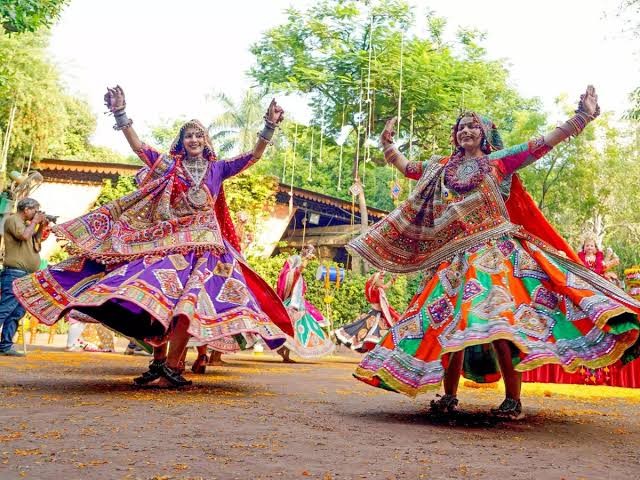
Garba

17.10.2023
Garba , Daily Current Affairs , RACE IAS : Best IAS Coaching in Lucknow
|
For prelims: Garba,Dandiya For mains:Garba: Significance, The difference between Garba dance and Dandiya dance,Navratri,Folk Dances |
Why in the news?
Recently, the Vishwa Hindu Parishad issued a diktat to make the Aadhaar card mandatory for participants in garba and dandiya festivities during the nine-day Navratri festival in Maharashtra and India.
Key Points
The nine-day garba and dandiya dance is part of festive rituals in Maharashtra.
About Garba:-
- It is a community circle dance from the northwestern Indian state of Gujarat.
- It is performed around an earthen pot (garbo) with a lamp inside, which is called a ‘Garbha Deep.’
- The lantern symbolizes life the fetus in the womb, in particular.
- The pot itself is a symbol of the body, within which divinity resides.
- The word "garba" comes from the Sanskrit word garbha, meaning "womb."
- The dance form originated in the villages of Gujarat, where it was (and continues to be) performed in communal gathering spaces in the center of the village with the entire community participating.
- This style of dance is based on a circular pattern and is characterised by a sweeping action performed side to side.
- The performances of Garba also include singing and musical accompaniment traditionally provided by dhol and similar but smaller dholak, hand-clapping, and assorted metallic idiophones, like cymbals.
Garba: Significance
- The dance form of Garba celebrates fertility, honour womanhood, and pays respect to all nine forms of mother goddesses.
- The performance of Garba has spread beyond Gujarat to enjoy popularity not only in various parts of India but in Hindu communities across the world.
- Some of the folk dances similar to Garba are also found in several parts of India mainly in Tamil Nadu, in the southeast, and in Rajasthan, the northeastern neighbour of Gujarat.
- While performing Garba, devotees wear colourful costumes with some heavy jewellery-earrings, bangles, necklaces, etc.
- Men wear white pyjamas with a Ghagra which is a short round kurta above the knees and a pagadi on the head.
About Dandiya:-
- In Dandiya, both men and women energetically dance with colourful and decorated bamboo sticks, striking them to the beats of instruments like the dholak and tabla.
- The dance is a beautiful way of re-creating the battle that took place between the Devil and the demon.
- The colourful sticks used during Dandiya represent the sword of Goddess Durga, which is why this dance form is also known as ‘The Sword Dance.‘
- The sounds of the instruments playing are reminiscent of the metallic clangs that may be heard on the battlefield.
The difference between Garba dance and Dandiya dance.
- While both originate from Gujarat, they are performed on varied occasions. Dandiya is performed in praise of Lord Krishna in Vrindavan Gardens.
- Dandiya is also performed with colourful sticks while Garba involves more hand motions, clapping and circular dance formations.
- Garba is not only a festival confined to Gujarat but is prevalent across other Indian states and foreign countries like Canada, USA and Netherlands.
About Navratri:-
- It is an Indian festival celebrated throughout the country to worship the nine forms of the goddess Durga.
- This festival not only marks the triumph of good over evil (victory of Indian Goddess Durga over the demonic king Mahishasur)
- According to the Yogic culture, the summer solstice marks the beginning of the southern movement of the sun, this time is known as ‘sadhana pada’, during this time many festivals are celebrated which is of divine feminine nature.
- Mainly, Sharada Navratri is celebrated at this time.
- This festival starts right after Mahalaya Amavasya (Pitru Paksha), Mahalaya denotes the Devi Pada.
- This is the time when the whole northern hemisphere of the Earth generates the divine feminine gentleness.
- This is when Devi is celebrated with glory through the nine days of offerings, rituals, and celebrations.
Folk Dances
- Indian folk dances are traditional, celebratory, and expressive.
- They are performed globally for social events like weddings, festivals, and seasons.
- Both genders participate, often with musicians playing as dancers sing. Elaborate clothing is common.
- There are numerous structured, old-fashioned folk and tribal dances, but many more are developing right now.
- Indian folk dances, with their elaborate costumes and jewellery, form an integral part of the country's cultural heritage. Among them is Dumhal, a traditional dance from Kashmir, and Ras lila, performed during Janmashtami festivals.
Source:Indian Express